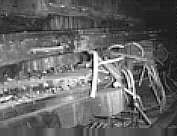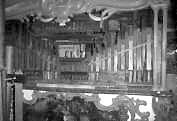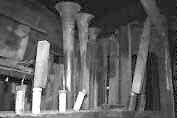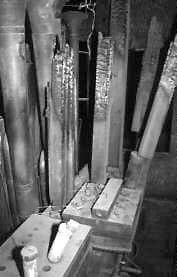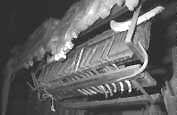




All rights reserved. This document, or any part of it, must not be reproduced in any format without prior written permission of the Fair Organ Preservation Society
©2025 - Fair Organ Preservation Society


A Gavioli Resurrected
by John Page
The invitation stated "Dean Organs present the unveiling of Mr & Mrs R Hayward's Grand 89-key G4 Gavioli & Cie organ, Serial No. 32, on Saturday 12th April 1997 at The Organ Works, Bristol."
I attended with Anna and Eleanor; it was certainly a grand affair. After pressing through the crowd and making conversation with those we know, we found ourselves facing a large sheet covering the organ. We were welcomed by Richard Dean who lowered the sheet to reveal the organ in all its splendour. A far cry from the mess which had graced my organ works in London during the 1980s!
We were then treated to a recital on the instrument which consisted, mainly, of books arranged by Nick Dean and three items composed by him for the occasion. During and after the fine buffet lunch provided by the Deans, we listened to more music.
The organ is believed to have been built c1905. Its serial number is very unusual as most French Gaviolis of this style should bear a serial number in the 89,000s and most German Gaviolis are not numbered.
The organ's history can be traced back in this country to c1926 when it was supplied, probably as a reconditioned instrument, to Tom Sheppard. It was originally fitted with wide side-cases which had been cut down to enable the organ to fit into the gallopers. The front shelf was also cut down and the bottom centre section of the front shunted back, so as to reduce the width. This was also probably why the figures were removed as the shelf was no longer deep enough to support them. The supply holes for the figures were blocked with French newspaper from c1926. It is possible that the organ was fitted behind the front from another, larger, Gavioli which had been used in a cinematograph show. The organ is reported to have been supplied to Tom Sheppard by Gaudin. Their sole UK agents in 1926 were the Showman's Stores, based both in Bristol and Streatham.
In 1936, the ride and organ passed to Joe Rowland of St Austell, Cornwall. During their ownership, the organ was looked after and tuned by Chiappa Limited and, sometime in the 1930s, Chiappa fitted a reed box to the organ, mounted high above the clarinets.
|
|
During the Second World War, it was acquired by Pat Collins Jnr for his Amusement Park at Colwyn Bay on the north west Welsh coast. In the 1950s, the Colwyn Bay site was run by Frank Charlton and, during this period, the organ lay derelict although the gallopers were sold on to the West Midlands. The organ's history during the following years is rather sketchy but it lost its drum cases and key frame and acquired protective end panels made crudely from hardboard. It was travelled in a ride purely as a show-piece as it was not in playing order. Its front was roughly daubed in yellow paint, with a touch of red and black, but the central panel painting escaped. One night in the early 1960s, after the ride had been sheeted up, a smouldering cigarette end tossed into the organ that evening started a blaze which caused extensive damage. Worst affected were the reed box and pipe tops, including the brass trombones, whose bells pointed up into the roof. Water, subsequently poured into the organ to quench the fire, was responsible for reducing to rust all the screws in the organ and further damage to the main chest and the feeders and two reservoirs which had not been replaced by a centrifugal blower as has befallen most other organs of this period. In 1984, the organ was discovered in a scrap yard in Mold and was transported to the London works of Page & Howard where most of the superficial fire debris was cleaned out. The idea was that I could restore the instrument in my own time. It remained there for four years, during which time the organ's front was loaned to Pinewood Studios as a prop for the film Gun Bus. Eventually, in 1988, it was reluctantly sold to a showman who, whilst transporting the instrument home, was involved in an accident. The organ trailer was hit from behind by a truck whose driver had fallen asleep! As the organ was already in a dilapidated state, the only additional damage was to the base of the case and one snapped crank rod. The organ changed hands again but, during its life in preservation, no real restoration work was ever carried out - until its present owner took a liking to the prospect of what could be a historic gem. When Dean Organs undertook the task, it was quite evident that the organ had never undergone any major changes in its life. The drums had been transposed, as evidenced by the metal conveyancing found inside, taking the action wind to the opposite ends. This was often done when the key frame was turned round to operate in the now familiar position. There would have been no room for the music with the bass drum beater at that end. Originally the music card would have entered the key frame and exited through the back of the organ, running in channels, and out at the other end. The original crank cover had been eroded by the card continuously passing over it. The only addition that appears ever to have been made was the reed box and its action relay. This had suffered serious damage in the fire and has not survived to the present day; only photographs remain. The double-row of steel reeds (about 80 in all) were actuated by a system of levers, each operated by double puffs. The box was complete with a pressure reducing reservoir. The Gavioli is of extreme historical significance to the preservation movement of this country as it is the only G4 organ imported into this country to work on the fairground which has survived to the present day without ever being converted to the Marenghi's Violin Baritone scale. It still has its original crank and double feeders and twin reservoirs. Operating on a wind pressure of 8¼ inches wg, under its original springs, the organ has a more than adequate supply of wind. The main action chest, which was in a seriously dilapidated condition, would more economically have been discarded and replaced by new but the decision was made to restore it and most other action parts. Thus the majority of the organ's action and pipes are original. Some pipes still bear scars of the disastrous fire. The only new complete rank of pipes in the organ are the bass 'box' reeds at the back. The originals had been lost since leaving London. All other pipes have been painstakingly restored to the extent of retaining some of the original violin freins, inscribed 'Systeme Gavioli'. The violins had been supplied from the scrap-yard in a black rubbish sack. They had literally fallen apart and it took many hours to piece them all together correctly. During this operation it was discovered that, unusually, there were three width scales instead of the normal two. The brass trombones, too, have been faithfully restored. New drum cases have been made for the organ. These were designed from studying photographs which existed of this organ and old photographs of similar model Gaviolis. Extensive patterns were designed and made at Dean Organs so that Woody White, woodcarver, could copy and carve replacements. The front was decorated by Dean Organs with all sign-writing, flower painting and the organ's seven figures being decorated by Richard Dean. The central panel depicting horses and riders was restored by Vicky Postlethwaite. During this restoration, it was discovered that the panel had been used previously, up the other way, as a painting of a female nude on a beach. During the organ's restoration its origin, France or Germany, never became obvious. The piccolos and brass clarinets appear to be French but the reed boots, turned in solid wood, and reed shallots appear German. The relationship between the German Gavioli works in Waldkirch and the Paris factory has never been truly established, although it is quite possible that, for the sake of efficiency, parts were manufactured in one factory for assembly into organs in the other. This could have taken place in both directions. However, the organ's overall appearance suggests that it was built in Paris, around 1905. |
|
|
|
|
|
|
|
|
|
|
|
The restoration which has been done enables today's preservationists to hear a genuine G4 Gavioli playing as it would have done in the early part of this century. I am indebted to Richard Dean for his assistance with this article.
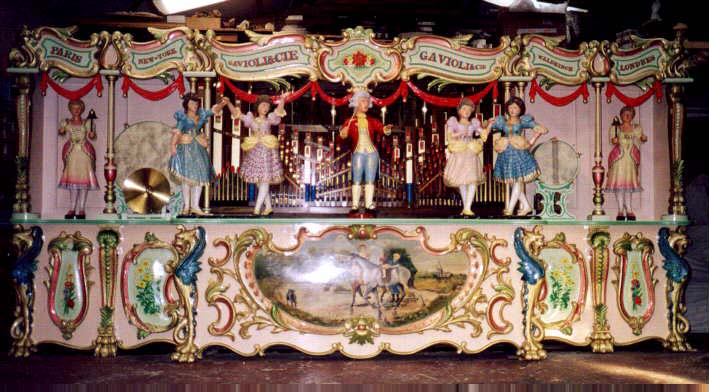
The restored organ in the Dean Organ Works
Copyright © John Page, 1997. All photos, John Page.
Originally published in edition 4 of The Key Frame 1997.

